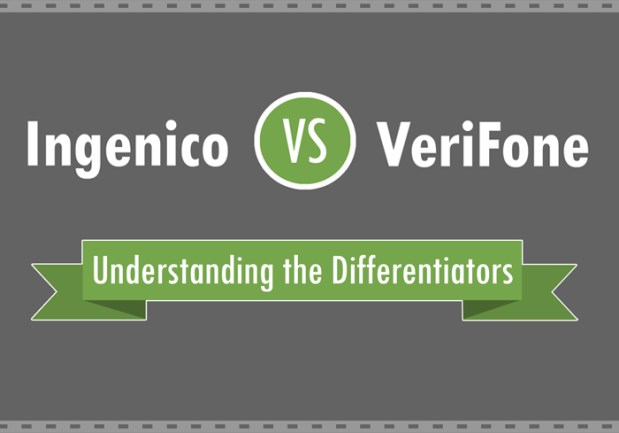Showdown At The POS: Ingenico versus VeriFone

Ever wanted to know how two similar players stack up when compared head to head? For the inaugural edition of our “versus” series we bring you VeriFone and Ingenico, the world’s leading makers of stand-alone POS terminals. Both have taken different approaches to their markets over the years, and today stand in very different places as the world moves to mobile and the US appears ready to adopt EMV. What do you think?
Times are good, at least potentially, for the two leading manufacturers of stand-alone point-of-sale terminals. The U.S. market is moving to EMV chip card acceptance, and there’s growing demand for terminals that can support advanced encryption and other security protocols to better protect transactions in transit.
Yet when looking at what’s at stake for the region’s – and the world’s – two top terminal makers, VeriFone Systems Inc. and Ingenico Group, it seems VeriFone is the most vulnerable, at least in the U.S. Here’s why.
VeriFone long has been the market’s leader in the region, where last year it captured a 51.5 percent share of terminal shipments to Ingenico’s 17.4 percent share, according to Nilson Report. Though still a wide gap, VeriFone’s 2013 U.S. shipment total of 936,000 represented a 17 percent drop from a year earlier, while Ingenico’s 317,000 shipment total last year represented a 47 percent boost, Nilson says.
Ingenico’s relative expertise with EMV terminals could be a factor. Also affecting the market is growth in integrated tablets, which is reducing use of traditional terminals among small and midsize merchants. With VeriFone’s local dominance in the market, it’s especially vulnerable to that growing trend.
Conversely, Ingenico rules globally, holding a 30 percent shipment share last year (up from 28.3 percent a year earlier) to runner-up VeriFone’s 18.6 percent share (down from 25.8 percent). Ingenico’s global shipment total of 6.7 million devices represented an 18 percent boost from 2012, while VeriFone’s 4.2 million shipments represented a 20 percent decline.
Indeed, when looking at these terminal makers side by side, it appears at little bit like advantage Ingenico. VeriFone last year replaced long-term leader Doug Bergeron with former Citibank executive Paul Galant, who has begun to put some strategic plans in place.
To address the changing markets, and to get their internal systems more aligned and efficient, both companies recently implemented changes designed to streamline operations. The companies have taken to using different tactics to accomplish their goals, mostly based on their own internal needs.
VeriFone recently launched an initiative to streamline the company’s operations under new CEO Galant’s vision to “become our clients’ most trusted, most secure and innovative partner by delivering terminals, payment as a service and commerce enablement solutions.”
To accomplish its goal, VeriFone moved to fix how it is managed by executing its three top company initiatives, which include redefining its global product-management processes and portfolio, re-engineering its R&D function, and improving its cost structure.
Though the initiative is a work in progress, the company has begun to identify areas needing fixing. Each of its more than 1,000 SKUs has been initially vetted, for example, and management has identified at least 25% for rationalization and replacement. In doing so, the company hopes to reduce complexity across the company, from development to procurement to sales and marketing and to customer support.
VeriFone also is addressing the overlap in its operating model through its third initiative, which is cost optimization, having identified more than 50 cost-savings projects.
Ingenico also has been busy streamlining its internal operations. To reflect what it says is its evolution from a payment terminals provider to a seamless payment services provider, the company in June changed its corporate brand name “Ingenico Group.”
Earlier in the year, Ingenico also combined its European business, or Euro-SEPA, and its Transaction business under a new entity. That initiative was built off Ingenico’s acquisition and integration of online payment-services provider Ogone. The new payment service now focuses on both offline and online transactions.
VeriFone, which not too long ago was in an acquisition mode, having acquired Hypercom’s U.S. operations in 2011, has been quiet of late in terms of merger activity. Ingenico, however, has been busy filling its own holes through mergers. In addition to its Ogone acquisition, the company also recently announced plans to acquire eCommerce payments provider GlobalCollect. GlobalCollect’s cross-border processing expertise will further help Ingenico fulfill its multichannel and to spread risk away from its terminal business exclusively. Ingenico also recently took on a majority interest in mobile commerce platform provider ROAM as part of a multichannel push.
Different strategies, similar goals. How the rest of 2014 pans out for the two terminal makers could depend on the success of what they’re doing now to address what they perceive as necessary fixes to push ahead.
Who do you think has the advantage?
Ingenico VS VeriFone Infographic (click image to download)

